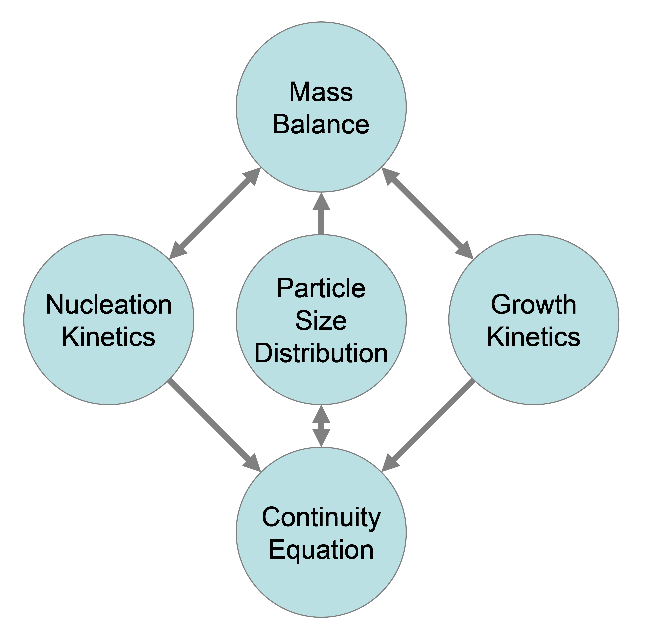Theory Overview
Based on the theory from Langer-Schwartz [1980Lan] the Precipitation Module (TC-PRISMA) adopts Kampmann-Wagner numerical (KWN) [2013Wag] method to simulate the concomitant nucleation, growth, and coarsening of precipitates in multicomponent and multiphase alloy systems. The KWN method is an extension of the original Langer-Schwartz (LS) approach and its modified (MLS) form, where the temporal evolution of the mean radius and particle density over the whole course of precipitation are predicted by solving a set of rate equations derived with certain assumptions for the rates of nucleation and growth, as well as the function of particle size distribution (PSD). The MLS approach differs from the LS with respect to the Gibbs-Thomson equations used for calculating equilibrium solubilities of small particles. The former applies the exact exponential form, whereas the latter takes the convenient linearized version. Instead of assuming a PSD function a priori and working with rate equations for determining only mean radius and particle density, the KWN method extends the LS and MLS approaches by discretizing the PSD and solving the continuity equation of the PSD directly. Therefore, the time evolution of the PSD and its nth moment (0: number density; 1st: mean radius; 3rd: volume fraction) can be obtained altogether during the simulation. The key elements of the KWN method are the models for nucleation and growth under the mean field mass balance condition and the numerical algorithm for solving the continuity equation of the PSD. Coarsening comes out naturally without any ad hoc treatment.
The key elements of the KWN method and their relationship as implemented in the Precipitation Module (TC-PRISMA).
Integration of the Precipitation Module into Thermo‑Calc
Precipitation Module (TC-PRISMA) is integrated with Thermo‑Calc in order to directly get all necessary thermodynamic and kinetic information required in the KWN method. For industry relevant multicomponent alloys, thermodynamic and kinetic databases and calculation tools have to be used in order to obtain various quantities in the multicomponent models for nucleation and growth, such as the driving forces for the formation of embryos and their compositions, the atomic mobilities or diffusivities in the matrix, the operating interface compositions under local equilibrium conditions, the Gibbs-Thomson effect, and the deviation from local equilibrium due to interface friction etc. With Thermo‑Calc and the Diffusion Module (DICTRA) as well as the accompanying databases, all these properties and effects can be calculated without unnecessary and inaccurate approximations.
In the following topics, various models and numerical methods implemented in Precipitation Module (TC-PRISMA) are introduced. Unless specified, spherical particles are assumed in the discussion.
References
[1980Lan] J. S. Langer, A. J. Schwartz, Kinetics of nucleation in near-critical fluids. Phys. Rev. A. 21, 948–958 (1980).
[2013Wag] R. Wagner, R. Kampmann, P. W. Voorhees, 'Homogeneous second phase precipitation', in Materials Science and Technology, R. W. Cahn, P. Haasen, E. J. Kramer, Eds. (Wiley-VCH Verlag GmbH & Co. KGaA, Weinheim, Germany, 2013), pp. 213–304.
